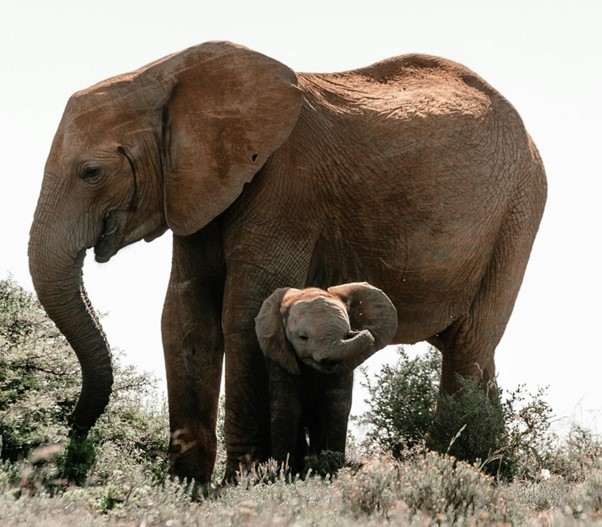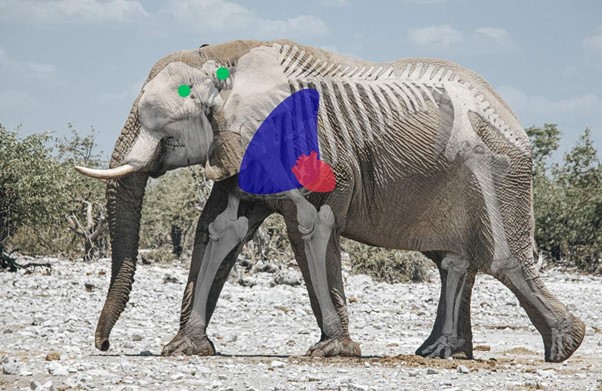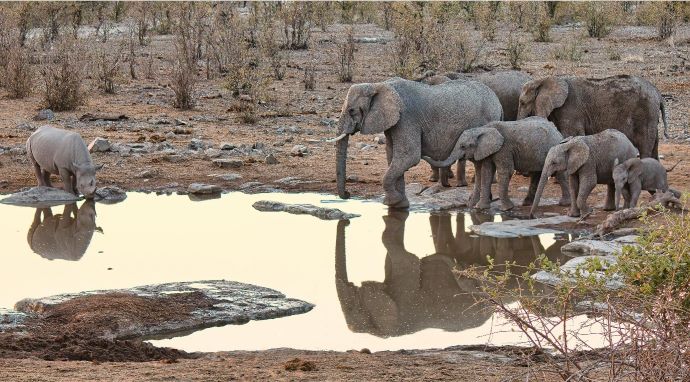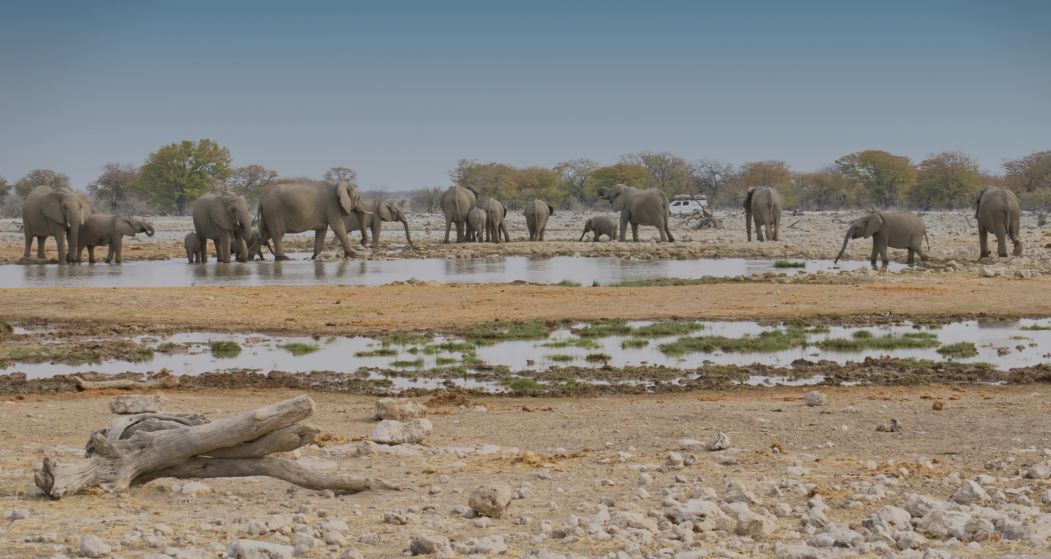Let us for just a moment, take a step and ask the question, why go Elephant hunting in Namibia, tuskless or not?
Elephant trophy hunting will more than likely be the toughest African hunt that the hunter will ever experience.
Elephant hunting will evaluate your patience, stamina and mental endurance with having to repeat the same activities day in and day out, looking for fresh tracks and heading out towards the African horizon.
An Elephant hunt will teach the hunter about success and disappointment, about your capabilities and about the importance of a continual focus on the task at hand. The safari will consist of all the key components, danger, euphoria and the possibility of the hunter becoming the hunted.
Elephant hunting in Namibia is one of the best adventures of African big game hunting and is considered the pinnacle of a big game hunters’ career. Sounds good to me, let’s head out!
[DYNAMIC-BLOGTABLEOFCONTENT]
About Elephants, a quick snap shot of the Adversary
The largest land mammal, a bull Elephant can stand more than eleven feet at the shoulder and can weigh it at over seven tons, a tank of an adversary.
Elephants can move through the landscape at a rapid speed and can easily camouflage themselves into the surroundings. These incredible creatures have excellent hearing and sense of smell.
An Elephant is a destructive feeder and can consume more than 450 pound of feed per day. Elephants are social creatures, and to hunt these majestic animals will be done on foot, up close and personal. Elephants, contrary to some beliefs, are not endangered. In fact, in certain African countries such as Botswana, Elephant populations far exceed carrying capacity as in the Chobe Reserve, in Botswana.
Magnificent Elephant hunted in Namibia
Why do some Elephants in Africa not have tusks?
Elephants are known to carry a sex-linked gene, which causes some Elephants in all Elephant populations to be tuskless. It is deemed probable that a gene version on the X chromosome caused the Elephants to be born tuskless and is lethal with male Elephants. This gene mutation is hereditary and is formed by two tooth genes.
Is Elephant hunting in Namibia regulated?
Yes, Elephant hunting is regulated by government and conservation organizations which set hunting quotas. A CITES permit is required to hunt Elephants in Namibia.
When is the best time for an Elephant hunting safari in Namibia?
The most suitable time Elephant hunting safari can vary, depending on factors such as the season of the year, weather conditions and herd behavior.
Elephants, like most of the dangerous 7 in Africa, are most active early in the morning or late afternoon meaning that during these times, the Elephants are on the move. Elephant hunting during these times will thus increase the hunter’s chance of “bumping” into an Elephant.
The Elephant hunting safari times may also be affected by local customs and regulations which may lay out the parameters of exactly when Elephant hunting may take place.
When is the best time to go on an Elephant Hunting Safari in Namibia?
Namibia, being mostly desert can become extremely hot. Elephant hunting in Namibia is best done in the winter and cooler months, which are from April to August. The dryer and cooler months also mean less vegetation. This will assist with tracking and spotting the tuskless Elephant.
How much will an Elephant hunting safari for Tuskless Elephant cost?
In Namibia, an Tuskless elephant hunting safari, depending on 14 or 21 days will cost between US $ 14000 and US $ 18000. The tuskless Elephant will not be exportable.
Where is the best place to hunt tuskless Elephant?
Tuskless Elephant are found all over Africa. However, the majority of Tuskless Elephant hunts are conducted within Zimbabwe. These Tuskless Elephants in Zimbabwe are specifically targeted by the Zimbabwean game department. The Zimbabwean officials are specifically trying to remove the gene pool responsible for tuskless Elephants and issue a specific quota for the hunting of the tuskless females. Remember, the cause, being the gene is hereditary.

Are tuskless Elephants rare?
About 6% of female Elephants found in Namibia will not have any tusks. In other places, such as the Gorongoza National Park in Mozambique, more than 50% of female Elephants over the age of 20 years old are tuskless. In the Kruger National Park in South Africa, about 3% of the females are tuskless. The Mana Pools in Zimbabwe has tuskless Elephants at 10% of the total population.
Is hunting a female tuskless Elephant more dangerous than a Bull Elephant?
Many experienced big game hunters consider the hunting female tuskless Elephants to be the most dangerous of all Elephant hunts. Elephant cows are more volatile than bulls and most certainly do not have a particularly good temperament. Tuskless elephant cows have been to Cape Buffalo, who have been badly shot and are out on the war path, but only much bigger.
In many instances, tuskless Elephant cows are protecting their young, so like when getting between a Hippo and the water, these tuskless cows have the ability to destroy anything in their path.
Can a Bow be used when Tuskless Elephant hunting in Namibia?
No, a bow may not be used when hunting tuskless elephant in Namibia, nor any other dangerous game animal. The prohibition includes the use of crossbows.
The Tuskless Elephant Hunting Safari
Elephant are highly intelligent. Hunting and tracking an Elephant on foot is classified as one of the world’s most classic hunts. Elephant hunting in Namibia will take the hunter to some of the remotest and wildest places.
In many ways, hunting a tuskless Elephant is all about the experience, not necessarily the size of the ivory. No part of the trophy is exportable. In reality, the hunter, while enjoying a superb hunting adventure is showing commitment to conservation by contributing funds to wildlife management initiates. So, instead of having 50 to 70 pounds of ivory in the trophy room, this can be replaced with photographs of the Elephant hunt. Just as memorable, and by an exceptionally long stretch, a lot more affordable.
It has always been my wish, and dream, that when I am long dead and buried deep in the ground, that my grandchildren can look up at a few photos in the trophy room and say, check the “old man” and the Elephant he hunted in Africa.. Such awesomeness!!. But, an Elephant hunt will soon be on the horizon, so we can see how that hunting safari unfolds.
Besides the cost of the Elephant hunting safari, the hunter, should the hunt be for a trophy bull Elephant will still need to incur all the additional costs of dip and pack, export and taxidermy. For those like me without a bottomless wallet or purse, I would prefer to utilize those funds elsewhere and pursue more of the dangerous 7 in Africa. You will still have hunted the most classic and exciting hunt ever.
Elephant Shot Placement (A)
Where and how to shoot a Tuskless Elephant is a complicated matter. It all depends on whether or not the hunter will be taking the brain shot from the side, or the brain shot from the front. The brain shot, often referred to as the classic shot when hunting tuskless Elephants is that the professional hunter will immediately be able to tell whether or not the first shot was an immediate success or not.
Elephant shot placement is further complicated by, when taking the brain shot, the angles between the brain and the hunter need to be considered. The other possible two shots when hunting tuskless Elephants will be:
- The Broadside shot into the heart and lungs
- The Fleeing Shot, into the spine and hip joints in an attempt to anchor the beast.
We have published an extensive piece on Elephant shot placement to explore further details.

Elephant Shot Placement B)
An Elephant cow is like a Cape Buffalo. While the Elephant remains standing, put as many bullets as you can into her. A tuskless Elephant cow, if shot in the heart, or in the guts will react in a remarkably similar way. In this moment, there is no such thing as too much lead or too much gun. Even when she goes down, reload as quickly as you can as there be more Elephants which move into the shooting arena.
Most importantly when hunting an Elephant, tuskless or not is listen to your professional hunter. He or she does this every day and is employed to ensure a quick and humane death for the Elephant and for your protection.
Should the Rifle be equipped with a scope when Elephant hunting in Namibia?
Call me a little nostalgic, but Elephant hunting is a tradition which has been followed since the 17th century. As hunting a tuskless Elephant is bound to be up close and personal, as long as the hunter can shoot accurately, a rifle with open sites is a consideration.
I think the old classics, like the .416 Rigby or any double rifle will work really well. If a scope is going to be fitted, I would suggest using a low powered scope such as a 1 x 4 magnification. Considering that a second or follow up shot may be required, the hunter would prefer to have a glance at the actual target, and not a wall of grey clouding your vision.
How to track the tuskless cow when Elephant Hunting in Namibia
Trackers in Namibia are absolute rockstars and know their stuff. Most trackers in Namibia are of Bushman decent and tracking African game animals has been done for generations.
The trackers even more so than the chef and professional hunter will have more influence over the success of your tuskless Elephant hunt than any other team member.
If you cannot find the tuskless Elephant cow, you cannot hunt it. It really is just that simple. I personally have tried to read the sign these trackers follow, and besides the obvious, it is just not possible. It is like the average man trying to rewire a helicopter or do open heart surgery (where the patient actually lives after the procedure. They are absolute professionals in every aspect.
Besides being able to read sign, these trackers are fearless and will happily put their lives in your hands. The more one thinks you know about tracking, the more these guys “make magic happen” and you realize your skill set is, well “horrific.”
When tuskless Elephant hunting in Namibia, the trackers will follow a spoor that they think can be “caught up to” in a single day, and these guys can cover ground at a rate.
If the hunter has not had a visual on the Elephant herd, the tracker will only follow herds big enough to possibly have a suitable tuskless cow, of the age to be hunted.
You will notice, as the tracks are being followed that the trackers and scouts, along with the professional hunter will randomly stop and check the inside temperature of the piles of dung left by the herd. The warmer the dung piles is inside, the better. This means that the herd cannot be too far ahead.

How to get close to the quarry when tuskless Elephant hunting in Namibia
The strategy will vary depending in which area of Namibia you are hunting. Elephant hunting in the Caprivi area of Namibia is far more open then when hunting elephant in areas such Bushmanland.
In visibility is not particularly good, you will be able to hear the branches breaking, or be able to hear the Elephant move, or listen to the rumblings of their stomachs. Make sure to be standing downwind.
At this juncture of the hunt, the trackers will fall out of the position and the professional hunter will move you into position, evaluating your stalking skills in the sand, or the dry winter grass. Make sure that you check every piece of ground before setting your boot down. Shooting distance on the Elephant can be anything from ten to thirty yards, depending on the visibility. The banging sound you will hear at this point may just be your heart trying to climb out of your chest cavity.
Listen carefully to every instruction that your professional hunter gives. Elephant hunting in Namibia is not for the arrogant, people lives are at stake.
The Elephant Hunting Safari and the accommodations
Tuskless Elephant hunting in Namibia, with a reputable outfitter will not mean that after a long day of walking and following tuskless Elephant, that the hunter has to suffer in terms of sacrificing comfort and facilities.
Elephant hunting outfitters in Namibia know how to ensure you sleep well, have great food and enjoy every aspect of the Elephant hunting safari. Tuskless Elephant hunting safaris in Namibia can span a period of three weeks, excluding all the international travel days, so home away from home is a good moto.
If you do have any special dietary requests, or other needs, be sure to let your outfitter know in advance. Elephant hunting grounds are far away from cities and supply stores.

Conclusion: Life is short, call in and go tuskless Elephant hunting in Namibia, it will be well worth the effort and memories made.
Author: PC van Wyk
